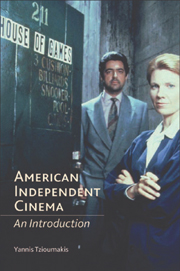Book contents
- Frontmatter
- Contents
- Analytical Table of Contents
- List of Tables
- List of Case Studies
- List of Figures
- Acknowledgements
- Dedication
- Introduction: Problems of Definition and the Discourse of American Independent Cinema
- Part I American Independent Cinema in the Studio Years (mid-1920s–late 1940s)
- Part II The Transitional Years (late 1940s–late 1960s)
- Part III Contemporary American Independent Cinema (late 1960s–present)
- Epilogue: From Independent to ‘Specialty’ Cinema
- Bibliography
- Index
Introduction: Problems of Definition and the Discourse of American Independent Cinema
- Frontmatter
- Contents
- Analytical Table of Contents
- List of Tables
- List of Case Studies
- List of Figures
- Acknowledgements
- Dedication
- Introduction: Problems of Definition and the Discourse of American Independent Cinema
- Part I American Independent Cinema in the Studio Years (mid-1920s–late 1940s)
- Part II The Transitional Years (late 1940s–late 1960s)
- Part III Contemporary American Independent Cinema (late 1960s–present)
- Epilogue: From Independent to ‘Specialty’ Cinema
- Bibliography
- Index
Summary
American independent cinema has always been a notoriously difficult concept to define. This is primarily because the label ‘independent’ has been widely used since the early years of American cinema by filmmakers, film critics, industry practitioners, trade publications, academics and cinema fans, to the extent that any attempt towards a definition is almost certainly destined to raise objections.
For the majority of people with a basic knowledge of American cinema, independent filmmaking consists of low-budget projects made by (mostly) young filmmakers with a strong personal vision away from the influence and pressures of the few major conglomerates that control tightly the American film industry. Far from the clutches of AOL Time Warner, Sony Columbia and Viacom Paramount, which are mainly in the business of producing expensive star vehicles and special-effects-driven films that bring larger profits from DVD sales and merchandising than from theatre admissions, independent filmmakers create films that stand against the crass commercialism of mainstream Hollywood while often pushing the envelope in terms of subject matter and its mode of representation. As film critic Emmanuel Levy put it, ‘ideally, an indie is a fresh, low-budget movie with a gritty style and offbeat subject matter that express the filmmaker's personal vision.’
This ‘ideal’ definition immediately brings to mind films such as Return of the Secaucus Seven (Sayles, 1980), Stranger than Paradise (Jarmusch, 1984), She's Gotta Have It (Spike Lee, 1986), Poison (Haynes, 1991), Straight Out of Brooklyn (Rich, 1992), Clerks (Kevin Smith, 1994), Welcome to the Dollhouse (Solondz, 1996), The Blair Witch Project(Sanchez and Myrick, 1999) and many other films that emerged post-1980 as low-budget ‘alternatives’ to the considerably more polished, expensive and conservative films produced and distributed by the major conglomerates.
- Type
- Chapter
- Information
- American Independent CinemaAn Introduction, pp. 1 - 16Publisher: Edinburgh University PressPrint publication year: 2006



